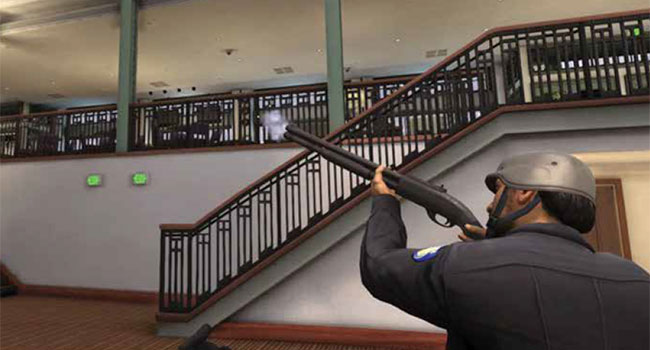
Campus Survival
A simulated virtual computer program is training teachers, faculty and students to survive an active shooter situation
- By Sydny Shepard
- April 01, 2018
Training for an active shooter situation can be the difference
between a brief disturbance on campus and a mass
shooting. It is the training programs that give administrators,
faculty and students the tools they need to have
live-saving instincts in the face of pure terror. Now, the
Army and the Homeland Security Department intend to give educators
hands-on experience when it comes to active shooter situations.
Using cutting-edge video game technology, the Army and DHS have
created a computer-based simulator that can train everyone on a campus,
from teachers to first responders, on how to react to an active
shooter scenario.
“With teachers, they did not self-select into a role where they expect
to have bullets flying near them,” Tamara Griffith, a chief engineer for
the project, told the Associated Press. “Unfortunately it is becoming a
reality; we want to teach teachers how to respond as first responders.”
AT THE EDGE OF SAFETY
The $5.6 million program, known as the Enhanced Dynamic Geo-
Social Environment, or EDGE, was originally created for police and
fire agencies and is similar to programs used by the Army to train
soldiers in combat tactics using a virtual environment.
The program is now being expanded to include civilian versions that
allow school teachers and other personnel to train for emergency situations,
including active shooters.
The virtual training program is created to be as realistic as possible;
the person training is asked to make life-changing decisions in a very
short amount of time and experiences the consequences of their choices,
sparking more reactions to choose from all while noises of gunshots,
children screaming and alarms are heard in the background.
For instance, the teacher can choose up to seven different ways to
keep students safe. From there, a student may be too afraid to move
forward with the teacher’s decision and the student becomes another
scenario for the teacher to face. The teacher has to quickly decide how
to react to keep that student and all the rest of the students safe.
The program is designed to get blood pumping and frighten an educator
so that they can react in a similar environment, if the time ever comes. Bob Walker, a project manager, told the AP that “once you hear
the children, the screaming, it makes it very, very real.”
CHOOSING A SCENARIO
The program has the ability to mimic several different scenarios,
including simulating a student shooter or an adult. The trainee can also
choose to react as a teacher, administrator or student.
Griffith said that the program designers listened to real dispatch
tapes from past school shootings to really understand the confusion
and chaos that goes along with active shooter situations. They also
spoke with the mother of a child killed in the 2012 shooting at Sandy
Hook Elementary School in Newtown. She helped to walk program
designers through each step of that tragic day.
“It gives you chills when you think about what’s happening on
those tapes,” Griffith said. “It tore us apart to listen to her and what
she went through.”
The real-life tapes and stories from those who experienced these
frightening situations first-hand served as a motivator for program
designers. In order to complete their main goal of training educators
to save lives when an armed attacker bursts into a school, you have to
check your emotions at the door and know it is all for a good cause.
The school shooting simulation is currently being housed at the
University of Central Florida in Orlando, and is set to officially launch
in the spring, but it isn’t the only simulation DHS is rolling out.
In addition to the school shooter EDGE program, DHS has launched
an active shooter scenario involving a 26-story hotel that includes
numerous possible environments for first responder training: a conference
center, a restaurant, or office spaces. As many as 60 people can train
on the program at once and can be located anywhere in the simulation.
“It’s important that this provides agencies like fire and law enforcement
an opportunity to train together,” Milt Nenneman, Homeland
Security Science and Technology First Responder Group program
manager, said in a recent Justice Department article. “Very seldom do
they have the opportunity to train together in real-life, and it is hard to
get those agencies time away from their regular duties.”
The main criticism in school safety and security is that schools wait
for a tragedy to strike before changing security measures, creating protocols
and talking about student safety. This new
program could be the proactive training needed to
keep campuses across the country safer in the face
of an active shooter.
This article originally appeared in the April 2018 issue of Campus Security Today.
About the Author
Sydny Shepard is the Executive Editor of Campus Security & Life Safety.